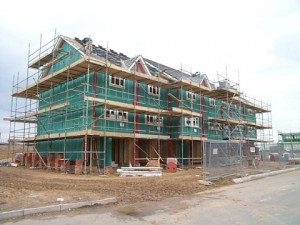Chelgate Local Newsletter – October 2017

Chelgate keeps you up to date with Planning this month…
Slough in green belt land grab
Slough Council has announced an audacious bid to meet its housing numbers by proposing a new settlement of 10,000 homes in South Bucks District Council. Needless to say, South Bucks has opposed the plan.
Like a number of other urban unitary authorities with tightly drawn boundaries (think Stevenage, Luton etc) Slough has struggled to meet its housing need within its own borders. This was not a particular problem when Regional Spatial Strategies existed but since their removal these urban authorities have struggled.
In this case Slough has felt forced to publish a “high level spatial plan” showing a 10,000 home “garden suburb” in South Bucks, an authority which has struggled to find space to meet its own need and which will undoubtedly fiercely resist this new incursion.
The added complication in this particular case is that South Bucks has been preparing its Local Plan in conjunction with neighbouring Chiltern District Council, so there the knock-on effects of Slough’s land grab will ripple outwards. As it is a significant proportion of South Bucks and Chiltern’s combined housing need is currently being taken by Aylesbury.
However, in a further twist, if the proposed new method of housing need assessment currently out for consultation is used in its current form South Bucks/Chiltern would see their housing requirement soar by 35% (1,400 homes). With Aylesbury’s own target being increased under the new system by several hundred new homes a year from its current target of almost 1,000 it seems it unlikely Aylesbury will be willing or able to cater for unmet need from South Bucks or anywhere else.
This is a complicated mess and one that will be difficult to resolve – and we may see something similar play out in other areas of the country. The Duty to Co-operate is just that – it is not, as one inspector notes “a duty to agree”. Labour, under Miliband, suggested these authorities would have a right to expand. With no such commitment from this government the arbiter is likely to be an unfortunate planning inspector.
Back to regional spatial strategies anyone?
Are councils using ‘Independent Housing Companies’ to dodge Right to Buy?
Last week saw Homes for Reading, a new ‘socially responsible housing company’ welcome its first tenants. The company is the latest in a line of wholly owned council businesses.
The intention behind Homes for Reading is to establish a commercially successful, socially responsible landlord in Reading in a bid to ease the city’s housing crisis. However, what it doesn’t do, at this stage, is build any new homes.
 The first property was purchased by Homes for Reading in September 2017 and was let within a matter of days at a full market rate. As the business grows, profits from market rate properties could cross subsidise properties for the registered homeless. Deals have been completed on a further four properties and there are reportedly several more flats and houses coming on the market over the next few months.
The first property was purchased by Homes for Reading in September 2017 and was let within a matter of days at a full market rate. As the business grows, profits from market rate properties could cross subsidise properties for the registered homeless. Deals have been completed on a further four properties and there are reportedly several more flats and houses coming on the market over the next few months.
The model is not just being adopted in Reading and not just by Labour councils. The London Borough of Newham has also explored using an independent company to address its housing shortage. 211 new homes will be built by developer Barratt London at Boleyn Ground for rent at 40%, 60% and 80% of market rates to address the problem of spiralling rents and plummeting levels of home ownership, which is particularly acute in the borough.
The as yet un-named company is a separate entity from existing company Red Door Ventures, set up in 2014 to deliver 3,000 homes in Newham. The council is understood to have borrowed £162million at a cheap rate through the Public Works Loan Board which is then loaned to Red Door Ventures at a commercial rate to circumvent restrictions on borrowing to build new council housing.
In Guildford, a £22million business plan was approved in July 2017 for North Downs Housing Ltd – a similar venture which will let properties to tenants with incomes between £30,000 and £65,000. The decision proved controversial as it emerged a majority of those employed by Guildford Borough Council itself don’t earn enough to be eligible to rent one of the properties on offer.
Guildford is exploring a number of alternative initiatives including opportunities for promoting Homes in Multiple Occupation (HMO) which are already common in cities and large towns. The council has also written to Communities and Local Government Secretary Sajid Javid asking for a change in legislation that would allow it to use the proceeds from the Right to Buy policy to purchase homes for shared ownership.
Yet another joint-venture scheme in Watford has seen the creation of Hart Homes, an independent company which Watford Borough Council has a 50% stake in. Hart Homes will hold properties for both market and affordable rent and is designed to reduce the number of households in the borough living in temporary accommodation.
Whilst these initiatives are certainly interesting, it is unlikely they will have a significant impact in addressing the housing crisis in London and the South East. Only Newham’s independent companies are actually delivering any new housing and these are currently on a very small scale. With questions beginning to be asked about how these schemes are being financed, and whether they are being used as legal loopholes to save local authorities money, these new ‘independent housing companies’ are certainly worth keeping an eye on.
Stamp duty revenues soar since reforms
Tax revenues since Stamp Duty was reformed three years ago have increased by a handy 18 per cent, swelling the Government coffers and giving them little reason to make further substantial changes despite a concerted campaign by the industry.
George Osborne, the then Chancellor and champion of home ownership, raised Stamp Duty on homes worth more £925,000, claiming to make the system fairer. This, in addition to the introduction of an Additional Rate Stamp Duty (ARSD) of three per cent on purchases of second properties, has resulted in receipts increasing by 18 per cent to £8.5bn in England and Wales. However, it is a mixed picture as there has been a fall in the overall number of transactions of eight per cent.
Given the exorbitant price of housing in the capital, changes have hit London hardest. Total receipts from the city, which accounts for over a third of all Stamp Duty revenues, only increased by one per cent to £3.4bn. The Prime Central London market actually showed a 10.3 per cent fall, with London overall seeing transactions across all price bands fall by almost a fifth (17%). Agents are linking the fall at least in part to the change in the duty regime.
Some will view this as the start of an overdue rebalancing of the housing market, but others would suggest that the changes coupled with worries about Brexit were going to impact disproportionately on the London market and will only be temporary.
Sajid Javid breaks a sweat over the housing market
Sajid Javid, Secretary of State for Communities and Local Government, addressed the Tory faithful about the UK’s broken housing market in his speech at the Tory Party Conference. Although most reporters were fixated on his rather embarrassing ‘nervous sweats’, he made some important points for the future of our housing market and the Conservative’s commitment moving forward.
Of course, he couldn’t go through a whole 20-minute speech without dropping in a dig at the Labour party. Explaining that Labour previously destroyed the hopes of young people by destroying the housing market with their “disastrous policies” of higher taxes, uncontrolled spending, ill-conceived nationalisations and the return of rent controls. He condemned them for not prioritising  the development of new houses.
the development of new houses.
Sajid Javid pointed out the injustices in the housing market, mainly the difficulties that young people experience when trying to get on the housing ladder. To an audience largely made up of the homeowning generation, he confirmed that the Government is committed to market, although warned that this is no simple task. His solution? Better understanding of the number of homes which actually need to be built. This enabled him to point to his consultation on the proposed new measure of housing need, which is out for consultation now.
Javid also declared the Government needed to focus on building more homes across the country. We now know that the big announcement on social housing funds (£2bn) was being saved for Theresa May’s speech. The figure has been considered rather lack lustre by the industry.
What he didn’t address is also important. To a room full of home owners, many of whom come from the countryside or leafy suburbs, he didn’t address the issue of putting solid local plans in place or what the government would do to push them through. He didn’t give any more detail on the Housing White Paper and when we can expect to see it come into force and he wasn’t able to say when the NPPF reforms would be announced.
So housing may indeed be one of the main focuses of the Government’s agenda, and “the biggest barrier to social progress in our country today” but this speech didn’t take us much further forward than we were before.
Some advancements have been made since Sajid Javid gave his speech to conference. Theresa May’s speech included some interesting language around homes, including the first real commitment to social housing from the Conservatives. We can see that this is a real focus for the Party in the time moving forward and there are swirling rumours about Phillip Hammond’s plans for the Budget, which will be announced on Wednesday 22 November.
Local Plan Updates
Chelmsford City Council – The Council has announced a delay during the recent Development Policy Committee and will be reviewing the consultation draft of the Reg 19 document on 30th November. The Council expect the consultation to start in the second week of January 2018 and will run for six weeks.
Cherwell District Council – The Reg 19 consultation is now closed as of 10 October and the Council is reviewing all of the comments they received. The Council is expecting to submit the plan to Government in April 2018, with the examination following this in April-August 2018.
Dacorum Borough Council – Dacorum Borough Council (DBC) discussed the local plan issues and options paper in Cabinet last night (17 October), clearing the plan for consultation.
DBC had deferred the discussion from September to better understand the impacts of the DCLG standard housing need methodology. Depending on how quickly the council progress their plan, the methodology could either see a decrease in their housing need over their own assessment if they are able to pass it quickly, or a significant increase if they delay (if the existing core strategy becomes five years old without a new plan in place). Perhaps unsurprisingly under the circumstances, the Cabinet approved the review documents and the (Reg 18) consultation goes forward to meet the timetable.
Councillors were keen to stress the Reg 18 consultation contains all of the sites promoted – no decisions on any sites had been made. There was also a further ‘call for sites’. The consultation also contains a range of alternatives, seeking comment on three specific growth options: focus on Hemel, focus on the three main towns or spread the numbers equally across the borough.
Perhaps oddly, the consultation also seeks comments from the public on which housing need number should be used: the local SHMA assessment (756 pa), the DCLG figure using the new standard methodology (602 pa), or an increased DCLG number of around 1,100 homes pa (to be used if Dacorum’s core strategy is five years or older, which it will become in September 2018). It seems extremely unlikely that the public will opt for the highest figure.
The consultation will start in November and conclude before Christmas. The pre-submission local plan will be published in the spring with submission scheduled for the autumn of next year.
East Herts District Council – The examination of the Local Plan started earlier this month, by Planning Inspector Christine Thorby. The Council submitted a response to the Inspector’s questions on Objectively Assessed Need and Employment during the Hearing Sessions which are due to conclude before the end of the year. Both documents can be found here. The Council expects to adopt the plan in December 2017.
Epping Forest Borough Council – Epping Forest District Council will now be publishing its pre-submission local plan in December. There is a new provisional council meeting scheduled for December 14. This means the local plan will be discussed at Cabinet the week before (December 7) and published seven days ahead of that, on November 30.
It is clear EFDC is seeking to get its plan submitted before the March 31st deadline to avoid having to use the new standard methodology for assessing housing need published by DCLG in September. It will, however, still need to include the uplifted numbers from the HMA which has followed the East Herts local plan inspection.
The council received over 3,000 comments to its second Regulation 18 consultation last year, most objecting to the urban intensification by developing on open green spaces in towns such as Loughton.
Epping is now publishing its local plan on the same day as neighbour Harlow. This could be a ploy to get all the bad news into the public domain at once. This will include the bulk of the 16,000 new homes planned for Harlow and Gilston Garden Town, which includes four large sites in Epping
Epsom and Ewell Borough Council – The Issues and Options consultation was launched on 25 September and will run until 6 November. The Council is also consulting on the Sustainability Appraisal of the consultation document, which can be found here. All comments on the Sustainability Appraisal must be submitted by 6 November. The Council will consider the consultation responses in December 2017 and anticipated that the pre-submission consultation will start in March 2018, with the estimated date of adoption being December 2019.
Medway Council – The Council are still working on the publication of the draft local plan which should be published by the end of this year. The Council anticipates that the Publication of the draft Local Plan will be in December 2017 or January 2018. The Council is then working towards the submission of the Local Plan for examination in Spring 2018 with adoption being in 2019.
Mole Valley District Council – The Council has now analysed the responses it received during the public consultation which lasted from 1 July to 1 September. Their summary of the Issues and Options consultation can be found here. The Council anticipates that it will submit the draft Local Plan to the Government in Spring 2018, with examination being in Summer 2018 and estimated adoption in Autumn 2018.
Sevenoaks District Council – The Issues and Options Consultation closed on 5 October and the Council is currently reviewing the comments they received online. The Council believes that it will be holding the Draft Local Plan consultation in Spring 2018 and that the Pre-Submission Publication will be in Summer 2018. It anticipates that it will submit the Local Plan to the Government in Autumn 2018 and that the Plan will be adopted in Summer 2019.
Slough Borough Council – The Council is using the responses received from the Issues and Options Consultation, which closed in February 2017, to write the Preferred Options document. The Council presented a summary report of the consultation responses to the Planning Committee in July and are now continuing to work on the final summary report. The Council anticipates it will be ready in Winter 2017.
South Oxfordshire District Council – Before the Local Plan is submitted. South Oxfordshire District Council is running a six-week publicity period from Wednesday 11 October, until Wednesday 22 November. This will be an online consultation, although it will be different to the ones previously held. The Planning Inspector dictates specific questions that should be asked during this period, relating to the legality of the plan. During the six weeks the Council will also be hosting eight drop-in events across the district to help explain the publicity process and how to submit comments online. The Council expects to submit the Local Plan to the Government later this year and is looking to hold the public examination in Spring 2018. It anticipates that the Local Plan will be adopted in Summer 2018.
Tandridge District Council – The Reg 18 consultation closed on Monday 9 October. The Council are currently reviewing all responses on which garden village site is the most suitable moving forward. The next iteration of the Local Plan is intended to be one which has the content and form of the document to be submitted to the Planning Inspectorate for independent examination. However, prior to submission there will be a further public exhibition in 2018, where members of the public will be invited to comment on the document.
Waverley Borough Council – Following the examination hearings, the Council has prepared some main modifications to the Plan for public consultation to make the plan sound. The public consultation on the changes started on 8 September and runs until tomorrow (Friday 20 October). The Council expects to adopt the Local Plan in June 2018.
Welwyn Hatfield Borough Council – The public hearings have begun at Welwyn Hatfield Borough Council and the Planning Inspector is currently examining the draft local plan and it is expected that he will look at Stage 2, Overarching Strategy at the end of this month. Although starting at a similar time to the East Herts Local Plan inspection, the WHBC inspector Melvyn Middleton, will be concluding the Inspection in the New Year. WHBC expect to adopt the Plan in April-June 2018.
Coming soon……
Breakfast rolls, coffee, and garden village chat. A discussion with senior Essex and Hertfordshire politicians to discuss their views on solving the housing crisis held in conjunction with Bidwells. Email rlass@chelgate.com to find out more and reserve a place.
For further information on how we can help with a planning problem please visit of Chelgate Local website or speak to Julian Seymour on 020 7939 7949.
